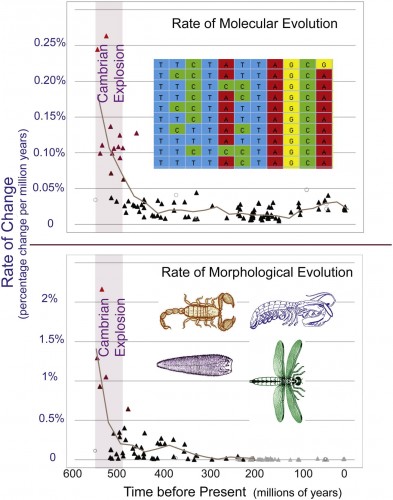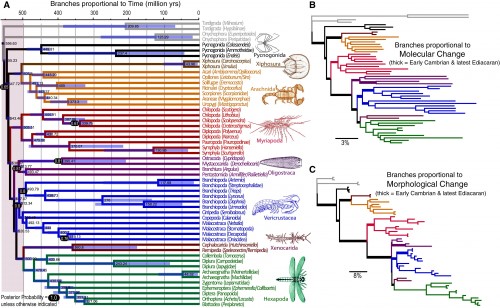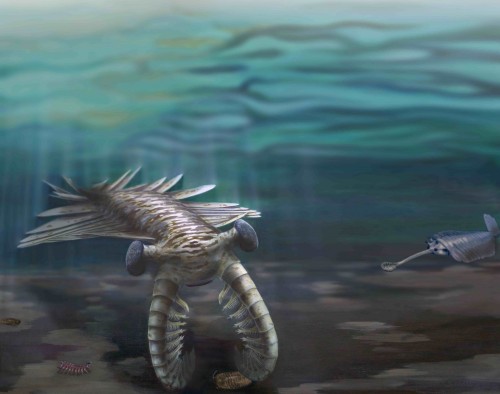
The near-simultaneous appearance of most modern animal groups appeared between 540 and 520 million years ago, during what is termed the Cambrian Explosion. This Big Bang of evolution has been problematic for many scientists, among them Charles Darwin. Darwin found it difficult to explain how this period of seemingly impossible rates of evolution fit within his framework of gradual evolutionary processes. Many others, including opponents of evolution, have echoed his sentiments, declaring that a much longer period of time would have been required to allow for such dramatic evolution. Recently, scientists from the UK and Australia have taken a closer look into the rates of morphological and molecular evolution that occurred over half a billion years ago by looking at the diversity of modern animals.
Since the fossil record during the Cambrian Explosion is extremely patchy, Michael Lee, Associate Professor of the School of Earth and Environmental Sciences at the University of Adelaide, and his colleagues decided to use modern animals to investigate this period time and its characteristic high rates of evolution. Arthropods (such as insects, crustaceans, arachnids, and their relatives) were used for the study because they are the most abundant and diverse group of animals during the Cambrian Period, and they have very complex and varied morphologies that have been preserved since this time.

Although past studies have looked at the diversity and morphological variety of Cambrian organisms, this study, published in Current Biology on October 7, 2013, directly quantifies the rate of anatomical change during the Cambrian Explosion and compares this with the evolution of arthropods since the Cambrian. However, because the fossilization process is patchy and does not preserve soft body parts, most complete fossils preserve less than one-third of the anatomical characters that are normally used to infer the evolutionary relationships between modern arthropods. Additionally, fossils from the Cambrian Period lack genetic information that could similarly be used to infer evolutionary relationships.
Therefore, the team decided to use a novel approach that simultaneously inferred rates of morphological and genomic change. They inferred the relationships of modern arthropods using the extensive morphological and genomic data available for living arthropods. These inferred relationships were then calibrated using the rich arthropod fossil record. Finally, they used molecular clock methods that they also adapted for morphological evolution. These clock methods estimate the duration of branches for living arthropods and also the amount of change that has occurred along these branches, thus computing the evolutionary rates for each branch. Additionally, using specific “relaxed-clock” methods can estimate how rates have changed over time by allowing for different rates on different branches.

Using 395 morphological characters, 62 protein-coding genes, and 20 calibration points from the fossil record, the authors inferred the evolutionary histories using a number of different analytical methods, and their relationship results are consistent with other recent research. Their results imply that most of the arthropod groups first occurred within about 40 million years of each other and before 500 million years ago. “It was during this Cambrian period that many of the most familiar traits associated with [arthropods], like a hard exoskeleton, jointed legs, and compound eyes,” says co-author Gregory Edgecombe of the Natural History Museum in London. Accordingly, the rates of evolution in this early time period are significantly faster than the rates since 500 million years ago. The average rate of morphological evolution in the Cambrian is about 4 times the average rate after the Cambrian, while the average rate of molecular evolution in the Cambrian is about 5 times the average rate after the Cambrian. The authors posit that this is due to extremely strong selective pressures on the animals during the Cambrian. Interestingly, even if the start of this evolutionary explosion is extended to 650 million years ago, spreading this evolution over more than 100 million years, evolutionary rates remain quite elevated. Lee says in the publication, “The pattern is consistent with many Cambrian lineages exhibiting accelerated—yet plausible—rates of morphological and molecular evolution.” Such a conclusion does not contradict Darwin’s theory of evolution.
Sources:
1. https://phys.org/news/2013-09-biologists-evolution-big.html
2. Michael S.Y. Lee, Julien Soubrier, Gregory D. Edgecombe, Rates of Phenotypic and Genomic Evolution during the Cambrian Explosion, Current Biology, Volume 23, Issue 19, 7 October 2013, Pages 1889-1895, ISSN 0960-9822, https://dx.doi.org/10.1016/j.cub.2013.07.055.
